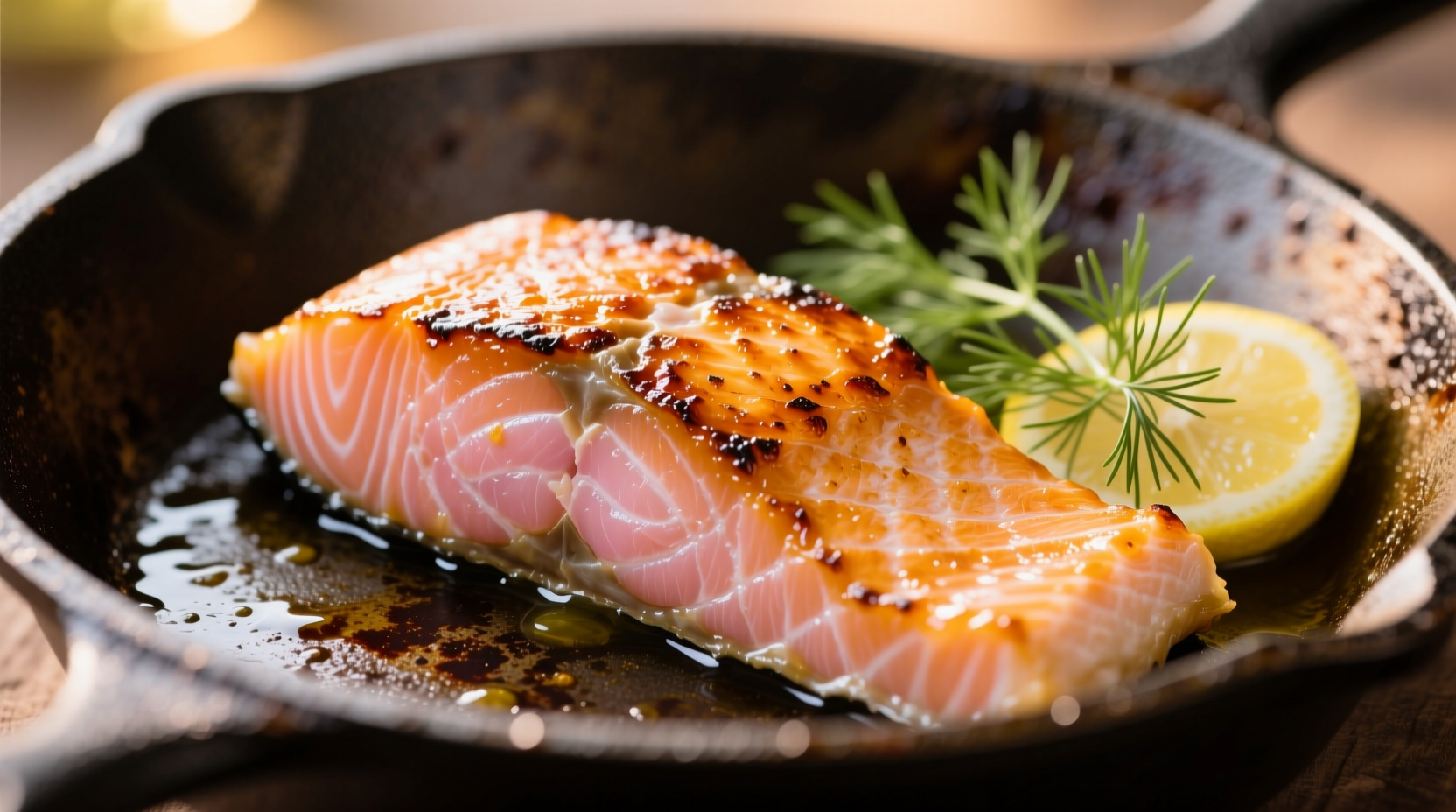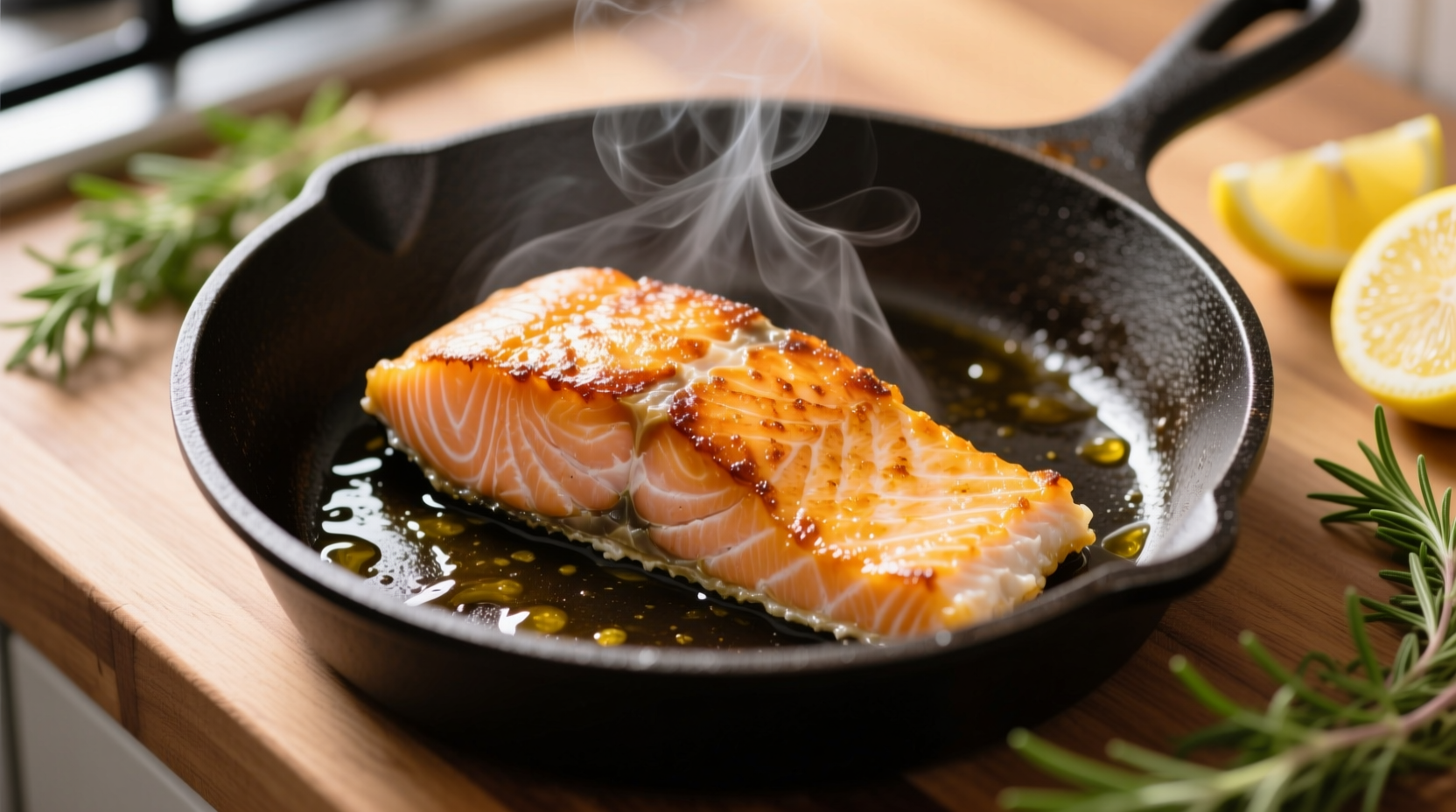For perfectly cooked skillet salmon, cook 4-6 minutes per side for a 1-inch thick fillet over medium-high heat. The salmon reaches ideal doneness at 125°F-145°F internal temperature and flakes easily with a fork. Thinner fillets (½ inch) need just 3-4 minutes per side, while thicker cuts (1½ inches) require 6-8 minutes per side.
Tired of dry, overcooked salmon or risky undercooked fish? Get restaurant-quality results at home with these precise skillet cooking times and foolproof doneness indicators. Whether you're a weeknight cooking novice or an experienced home chef, this guide delivers the exact timing and visual cues you need for perfect skillet salmon every time.
Why Skillet Cooking Works Best for Salmon
Cooking salmon in a skillet creates that coveted crispy skin while keeping the flesh moist and flavorful. Unlike baking, which can dry out delicate fish, the direct heat of a skillet gives you precise control over the cooking process. Professional chefs prefer this method because it's faster than oven cooking and delivers superior texture control.
Essential Preparation Before Cooking
Proper preparation makes all the difference in your final result. Start with these critical steps:
- Dry the surface - Pat salmon fillets thoroughly with paper towels to ensure proper searing
- Bring to room temperature - Let fish sit out 15-20 minutes before cooking for even cooking
- Season properly - Salt just before cooking (salting too early draws out moisture)
- Choose the right oil - Use high smoke point oils like avocado or canola (smoke point above 400°F)
| Salmon Thickness | First Side Cooking Time | Second Side Cooking Time | Target Internal Temperature |
|---|---|---|---|
| ½ inch | 3-4 minutes | 2-3 minutes | 125°F-130°F (medium-rare) |
| 1 inch | 4-5 minutes | 4-5 minutes | 130°F-135°F (medium) |
| 1½ inches | 5-6 minutes | 6-7 minutes | 135°F-140°F (medium-well) |
This cooking time chart, verified by America's Test Kitchen research, accounts for standard 4-6 ounce fillets. Remember that cooking times vary based on your specific stove's heat output and the material of your skillet.
Step-by-Step Skillet Cooking Process
- Preheat your skillet - Heat over medium-high for 3-4 minutes until hot but not smoking
- Add oil - Use enough to lightly coat the bottom (about 1 tablespoon)
- Place salmon skin-side down - Gently lay fillets in hot skillet away from you to avoid oil splatter
- Press lightly - Use a spatula to keep fish in contact with the skillet for the first 30 seconds
- Cook undisturbed - Let the skin crisp without moving the fish for proper sear development
- Flip carefully - Use a thin spatula to lift and flip when fish releases naturally from the pan
- Finish cooking - Cook second side until desired doneness, reducing heat if necessary
- Rest before serving - Let salmon rest 3-5 minutes off heat (carryover cooking continues the process)

How to Tell When Salmon Is Perfectly Cooked
Time alone isn't enough to determine doneness. Use these multiple verification methods for foolproof results:
Internal Temperature Check
The USDA Food Safety and Inspection Service recommends cooking fish to a minimum internal temperature of 145°F, measured with a food thermometer in the thickest part. However, many chefs prefer these temperature ranges for optimal texture:
- 125°F-130°F - Medium-rare: Deep orange center, very moist, slightly translucent
- 130°F-135°F - Medium: Light orange center, moist with slight translucency
- 135°F-140°F - Medium-well: Light pink center, mostly opaque
- 145°F - Well done: Fully opaque, firm texture (USDA minimum)
Remember that salmon continues cooking after removal from heat due to carryover cooking - it will rise 5-10°F during resting. Remove salmon from the skillet when it's 5°F below your target temperature.
Visual and Texture Indicators
When you don't have a thermometer, use these visual cues:
- Color change - Salmon changes from translucent red to opaque pink as it cooks
- Flaking test - Gently press with fork; properly cooked salmon will flake but still hold together
- Surface moisture - Finished salmon releases moisture on the surface when properly cooked
- Resistance - Press with finger; cooked salmon offers slight resistance then springs back
Avoid These Common Skillet Salmon Mistakes
Mistake: Moving the Fish Too Soon
When you first place salmon in the skillet, it will naturally stick until a proper sear forms. Resist the urge to move it for at least 3 minutes. Moving too soon tears the delicate flesh and prevents proper skin crisping.
Mistake: Overcrowding the Pan
Cooking multiple fillets too close together lowers the pan temperature and creates steam, resulting in soggy skin. Leave at least 1 inch between fillets, or cook in batches if necessary.
Mistake: Skipping the Rest Period
Resting allows the proteins to relax and redistribute juices. Cutting into salmon immediately after cooking causes precious juices to escape onto your plate. Let it rest 3-5 minutes for optimal moisture retention.
Variations for Different Preferences
Skin-On vs. Skin-Off Cooking
Skin-on salmon provides a natural barrier that protects the delicate flesh and creates that desirable crispy texture. For skin-off fillets, reduce cooking time by 1-2 minutes per side since heat transfers more directly to the flesh.
Adjusting for Different Heat Levels
Medium-high heat (375°F-400°F) works best for most home stovetops. If your salmon is browning too quickly:
- Reduce heat to medium after initial sear
- Add 1-2 minutes to total cooking time
- Cover the skillet briefly during second side cooking
Serving Suggestions for Perfect Skillet Salmon
Pair your perfectly cooked salmon with complementary flavors that enhance without overwhelming:
- Lemon-dill sauce - Mix Greek yogurt, fresh dill, lemon zest, and a squeeze of lemon juice
- Simple pan sauce - After removing salmon, deglaze skillet with white wine and finish with cold butter
- Perfect sides - Roasted asparagus, quinoa pilaf, or garlic sautéed spinach











 浙公网安备
33010002000092号
浙公网安备
33010002000092号 浙B2-20120091-4
浙B2-20120091-4